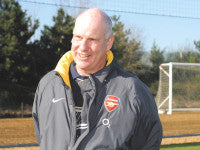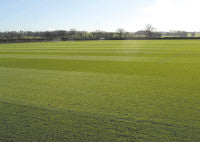Perfect makes Practice!
 Arsenal's STEVE BRADDOCK is performing trials with a growth retardant at the club's training ground. So far the results are encouraging.
Arsenal's STEVE BRADDOCK is performing trials with a growth retardant at the club's training ground. So far the results are encouraging.
There's an old adage in sport that practice makes perfect, and few have such perfect conditions for practice as The Arsenal. And that is largely thanks to the dedication and experience of the club's London Colney training facility Head Groundsman, Steve Braddock.
He is an absolute football fanatic, but now not so much for the game itself as the turf on which it is played. Steve confesses he would rather spend his Saturday afternoons productively working on the training pitches when it's quiet, than watching the team in a buzzing Emirates stadium.
His aim is to create playing surfaces that perform as well as any of the quality playing surfaces in stadiums throughout the world. Steve and his team make every effort to ensure the quality and consistency of the turf gives the bounce and speed that best suits the Arsenal team's fast and exciting style of play.
For the past year he has been trying out new Primo MAXX, to create a dense and even turf quickly after the annual pitch renovation, and consistently to try to acieve the optimum playing surface. He reports that, with applications every four to five weeks, he has achieved the desired finish, and brought about some useful management benefits.
Faster surface 
Steve highlights that the team's goalkeeping coach has been particularly impressed with the speed and zip off the grass surface in training this year and helping the keepers develop faster reactions. "We are looking to keep that perfect shine on the surface all the time. I think we are now getting faster ball speed from the same length of cut, and we are able to maintain the high standard for longer, which keeps the players happier."
Although Steve originally started out at Highbury, and managed both the club ground and training facilities for a time, he is now dedicated to the training ground where he can devote 100% of his time and attention to the ten pitches for first team, reserves and youth team training, along with the dedicated goal keeping area.
With the heavy demand from coaches and management it is always a tight run thing to get pitches extensively and properly renovated before the start of pre-season training. "Continued success in Europe is fantastic for the club, but extends demands on the training facilities for longer and puts extra pressure on the ground staff to achieve the renovation in even less time."
Steve delays renovation of one of the first team's three primary pitches until after the early pre-season training, when player fitness building is a priority and imposes very heavy wear on the established turf, rather than use a newly renovated pitch. It does, however, leave a very short gap over the late summer to successfully re-seed the last pitch before the area is required again in the training schedule, usually by mid-October - but this approach seems to work well, he reports.
All the pitches are re-sown with 100% dwarf ryegrass and, although they can all be irrigated over the summer, he highlights the crucial importance of getting seed sown early and growing well. "This year we have been trying Primo MAXX on newly renovated pitches at various intervals after germination, to see how quickly they will thicken out and fill the base of the sward."
Renovation techniques
Steve's recipe for renovation is to start within hours of the final scheduled training session finishing on each pitch. The existing sward is quickly killed off with paraquat, followed by an intensive rake and scarify to remove as much vegetative material as possible. Then a mighty flail - built to Steve's design and nicknamed 'The Beast' - skims off the remaining material to soil level, with a topmaker used to plane off any surface trash.
Typically 60 to 80 tonnes of sand is top dressed per pitch, with sand injection machines to incorporate the sand below the surface to improve aeration and drainage in areas that receive the most punishment during the course of the playing season.
The surface is then spiked to a depth of 6 inches and sand brushed in. Seed is sown with both a disc and a special vibrating seeder, passing in three directions for each machine to achieve as even a spread as possible. A final vertidrain minimises the risk of the soil surface capping and prevents surface water movement during periods of high rainfall while waiting for the seed to germinate, "the last thing we want at this stage is for the seed to be washed away."
Improved establishment
Seeking to improve the rapid establishment of the new turf and encourage a denser structure, Steve has experimented with Primo MAXX at different rates and grass growth stages. He found that a rate of 3.2lts/Ha worked best for him at his site, starting as soon as the new seed is growing vigorously. However, he points out that, whilst this works well for his intensive regime, the rate and frequency of application may be different at different sites. "Initially, trials looked very good and we wanted to continue to assess how they perform over the winter under intense training pressure."
Steve's key concern was that it wouldn't be able to recover from damage inflicted during winter training. In fact, he reports that, despite the incredibly wet conditions and the intensive demand on the pitches, there has been no difference in recovery rates and, if anything, the dense turf surface was better able to withstand training activities.
"We are normally waiting for the early spring growth spurt, once day length starts to increase in February and March, but really didn't need it this year," he added. The mild conditions in December meant there was no need for the undersoil heating, which is installed on two of the first team's training pitches, but, when it was switched on in January, there was a real surge in grass growth, which encouraged Steve to make an early application on one of the pitches to compare the effect, with very pleasing results.
He believes that getting the grass into regulation as it came out of the winter has made life easier for managing the cutting regime, giving more flexibility when rain delays mowing operations. With attention, and also some manpower switching to the mammoth renovation task in early spring, minimising labour chasing mowers is a big benefit, he points out.
The training pitches are constructed with a higher proportion of silt in the topsoil than would be conventional in a stadium construction. Whilst that is better for the cultivation of tough turf that can withstand daily use, the percolation and drainage is poorer and there is the potential for turf loss without careful management.
Although the heated conditions of the undersoil heated pitches and wet soils create the ideal environment for early turf diseases, the strong growth it encourages can generally withstand low levels of leaf spot without the need to treat with a fungicide. "The disease level has certainly been no worse on the early Primo treated pitches."
Management benefits
 The slower growth of turf brings benefits for season-long management operations, according to Steve. If the ground has been spiked or vertidrained, for example, he can leave it longer before needing to go across with the mower, and get even more benefit of the aeration treatment.
The slower growth of turf brings benefits for season-long management operations, according to Steve. If the ground has been spiked or vertidrained, for example, he can leave it longer before needing to go across with the mower, and get even more benefit of the aeration treatment.
Reduction in grass growth during the summer months also makes mowing quicker, and reduces the time and effort required to move clippings; all the clippings are boxed during mowing and removed for on-site composting.
"We are very aware of the environmental implications of our land management, along with the talked about imposition of green waste disposal or composting charges for the clippings, and possible water restrictions in the future. We are keen to explore any avenue that may help us reduce the environmental footprint of the operations, through reduced grass growth and more efficient water use" he adds.
Taking just the finest of trims off the top with each cut, to maintain the correct sward height, reduces stress on the plant, which in turn leads to better plant health. "We are also working on the possibilities of mixing fungicides with Primo MAXX during high risk periods for disease hot spots, such as October and November." Mowing continues every other day on all the pitches whenever possible in the height of the growing season, with slower vertical growth particularly welcome if weather conditions interrupt the mowing cycle.
Steve also cites Poa annua infestation as a problem on all pitches across the ground, but holding the sward suppressed has also tended to keep Poa small and less visible, with the desirable ryegrass predominating.
Tank-mix options 
Extensive ground renovation, drainage and amelioration has developed a well drained site, but with plenty of topsoil depth to ensure good stability for players twisting and turning during practice. That does mean the soil is inherently fertile and Steve has to balance the fertiliser inputs carefully, through a combination of small liquid feeds in every spray application, along with half rate to keep the turf looking pristine, combined with granular fertiliser every five to six weeks.
Barry McClosky of Avoncrop Amenity, which supplies Steve's turf products, highlights one of the key facets of the Primo MAXX application is that it can be safely tank-mixed with a liquid fertiliser, to save time and prevent extra wear and tear by running over the ground too often. "Some people believe that, because they are using a growth regulator, the turf doesn't need feeding, but trials, and Steve's experience, has shown a combination with a liquid feed stimulates the strong lateral growth and a dense turf structure. Mixing the products allows operators to take advantage of optimal spray window opportunities, when conditions are ideal for spraying."
An advocate of precision spray application, Steve and his staff undertake all the spraying, using a high-tech accurate sprayer at a water volume application rate of 500 l/ha - and taking the few minutes extra time to get it right.
Steve acknowledges that the construction of a huge new indoor training facility at the Colney site, due for completion in the early summer, could help ease pressure on the outdoor training pitches, but there is no substitute for the real thing and the coaches will always be eager to get out on turf whenever possible. Trying to manage the coaches' demands and accommodate their individual preferences for training on certain parts of the ground is a constant challenge when they have no concept of turf management.
A testament to the high quality training facilities Steve and the club provides has been increasing demand from visiting teams to use the ground, including international teams, England, Sweden, Brazil to name a few and the Colorado Rapids from the US, which has a link with the Arsenal team and management.
Steve is a great ambassador for the skills of groundsmen and remains willing to help others by sharing his knowledge.
